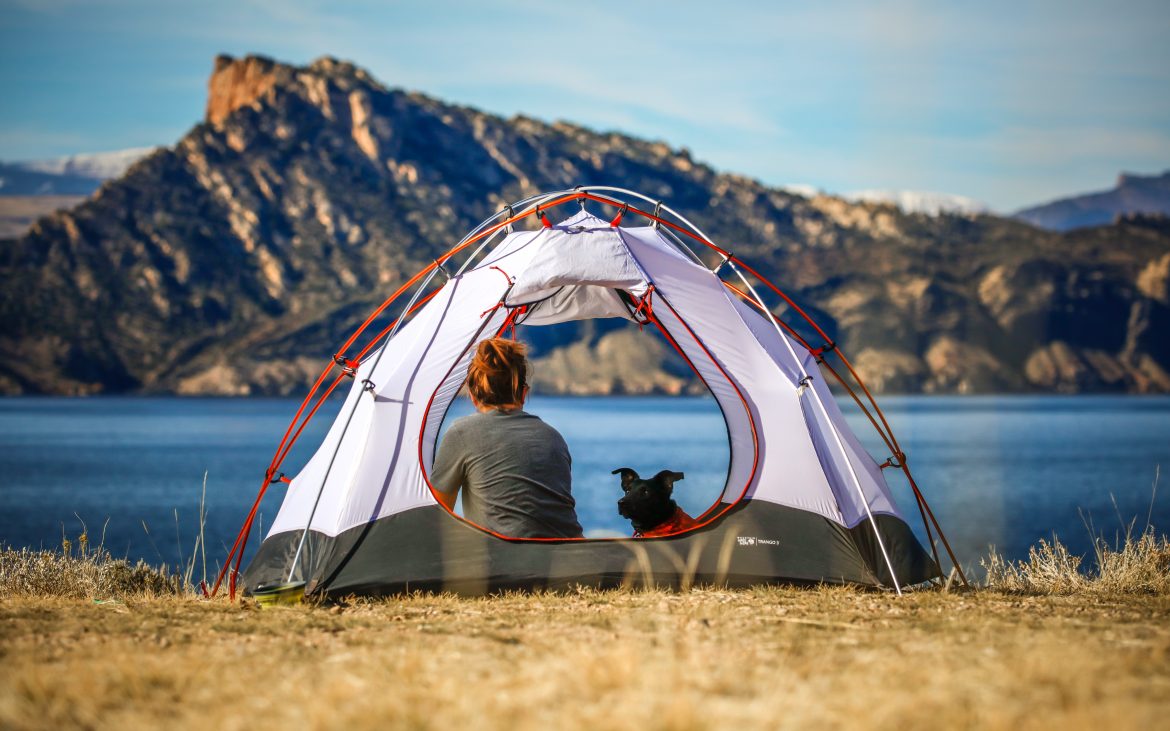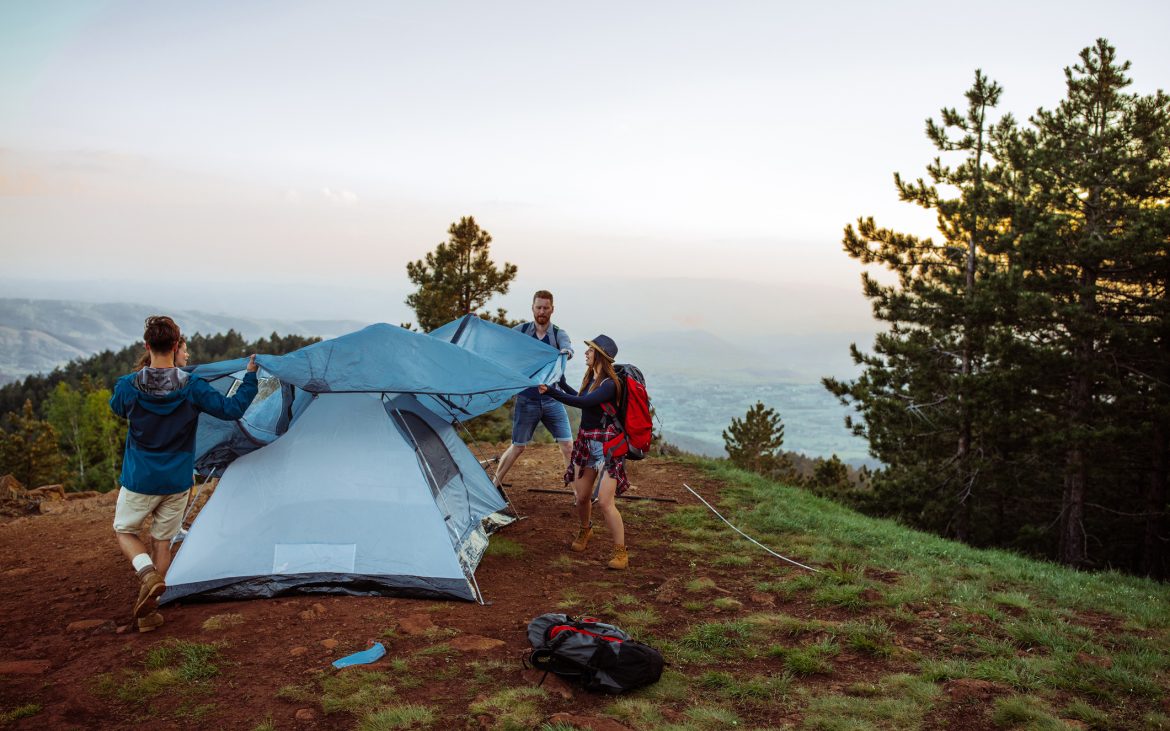Tents withstand extreme weather and resist natural elements, but they can still be broken beyond repair due to unchecked wears and tears.
Just because you’re roughing it, doesn’t mean you won’t be taking care of your camping gear — including your tent of choice. Knowing how to maintain and repair the tent will help it last longer. We’ve put together this beginner’s guide to tent maintenance, where we’ll drop some tips on how to better take care of your camping gear before, during, and after use.
Set-up
Setting up can make or break the tent maintenance game. Know how and where you can set up to avoid unnecessary damages.

Campers setting up the tent at the forest. Photo Credit: Getty Images, SolisImages
Test gear at home
Make it a habit to practice pitching your gear at home before you head out into the wild. Check if you have a complete gear set: the accessories, guy lines, and stakes must be accounted for. Carefully test the equipment, and do not under any circumstances whip the poles around, not at home nor at the campsite. We’ll get to that later.
Set up in a good spot
Extending the life of your tent means camping at established sites more often than not, especially since people comply with the Leave No Trace principle. The key to finding a good spot is to check for smooth, level, and clean ground. Clear away pinecones, twigs, or small rocks that might damage the material where you want the gear set up. Stay away from places that are near water, and make sure you’re a good few hundred feet away from the nearest source.
Be gentle with the equipment
Set up carefully. Unfold and fit the sections of the poles together one by one. Otherwise, you might weaken the poles and cause them to crack. Aluminum poles will become more brittle and will corrode when exposed to sea air and saltwater. A good way around this is to rinse the poles and let them dry.
Use a footprint
Prevent tearing as soon as setting up camp so you won’t have to clean it as often. A footprint is designed to shield your tent from outside elements. You can also use a groundsheet that is cut to match its shape. This is used as protection at the bottom from gravel and puddles.
Use
Upon using, be sure to not pry anything to the point of wear and tear. Also avoid water and sunlight.
Take care of the zippers
When you want to come in and out, ascertain that the zippers are not forced to glide when you pull them. Not only does this weaken the fabric, it will also cause the zippers to split. Use your other hand to hold down the track as you’re pulling it open with the zippers.
In the event that zippers do split, you can try latching it back together again. Pliers can also be used to mend them.
Leave footwear outside
Bringing dirt and soil inside might corrode the material and tear holes into the bottom. Another thing to remember is to avoid eating inside, as the food will attract rodents who can chew on the fabric.

Photo Credit: Unsplash, Patrick Hendry
Stay away from water
Water exposure can gradually break down the tent material. Avoid pitching in areas where water could pool around you because it damages the waterproofing. Make sure the air is ventilating inside when you’re using the tent to keep it from condensing.
Avoid extreme sunlight
The ultraviolet rays of the sunlight are harsh on the camping material. Exposure to too much UV light can cause fading, softening, or impairment.
There is camping gear that is UV resistant, but the same synthetic fabric can degrade with enough radiation. Once it has sustained enough UV damage, the material becomes non-repairable. If you do dry your gear, make sure the sun isn’t too blaring outside. Otherwise, hang your gear in the shade.
Maintenance
Going through the process of taking care of your tent before, during, and after its use will help preserve its longevity.
Washing
As much as possible, handwash the material. Fill a bucket with lukewarm water and soap and immerse it in the bath. Use a smooth sponge or a piece of white cloth to scrub the soiled areas. In parts where you waterproofed the floor and the seams, be careful not to rub too hard. Wash and rinse the fabric, then dry completely.
Use mild soaps that are free of detergents and fragrances. Detergents might contain chemicals that break down the DWR coating and fragrances will likely attract insects.
Air-dry your tent
Set up outdoors, preferably someplace with shade, to dry your camping gear after a weekend getaway. The fabric can grow mildew if stored with any moisture. You’ll be able to tell from the smell. Do not neglect to dry your tent because it can become flaky and tacky for use.
Removing mold
After a day out camping, it is not uncommon to find mold or mildew in the fabric. It might have been the condensation or the weather. Prepare it outside in sunlight to kill the mold before you remove any stains.
Use a soft brush to remove the mold from the material. Wash the fabric with a solution of hot water, vinegar, and dish soap. You can also use variations of this, such as Lysol or lemon juice and salt with hot water. For stubborn molds, avoid scrubbing it too hard. Instead, use a brush with bristles. Rinse the fabric gently and let it dry completely in the sun.
For mildew, bleach the stain. Wash the affected area with non-chlorine bleach. Colored fabrics need a solution of a cup of lemon juice and salt with a gallon of hot water, whereas color-safe fabrics need a solution of two tablespoons of bleach and a quart of water. As much as possible, do this outdoors to avoid leaving mold spores inside the house.
Prevention
Keep your tent dry
Do it as much as you can help it. It’s your responsibility to become meticulous about its maintenance.
Tents may accumulate moisture, so best expect mold and mildew to form, especially in humidity, which allows them to form inside when the dampness is trapped. While these are unavoidable, you can prevent mold and mildew during storage.
Waterproof your tent
Waterproofing will need two coatings. These will wear off eventually, so be sure to reapply every once in a while. Buy a tube of seam sealer for waterproofing the equipment. It can also be used for patching holes in the fabric.
First, apply urethane coating to prevent moisture from penetrating the material. The second layer is the DWR solution, which repels water.
Storage
Remember to store it in a cool and dry place after using.
Shake your tent
After taking it down, give it a good shake to make sure nothing is inside before you repack it. Remove the footprint.

Home is where you pitch your tent. Photo Credit: Getty Images, bernardbodo
Push, don’t pull
Poles are easier to remove than you think, so there is little need to be rough with them. They pass through sheaths on the exterior for easier removal, so just push them through and they’ll pop out. Then, break them down in the middle and divide the sections.
Dry after using
You know the drill. Dry the tent whenever you can. If the inside is even a bit wet, mildew is sure to grow. After a day outdoors, you need to make sure no moisture is left inside, because you’ll be leaving it in storage for a while. Roll it up before you put it inside. Simply stuffing it will ruin its form and stress the materials. At home, dry it again, and then store it in a loose sack someplace dry and cool.
The post Beginner’s Guide to Tent Maintenance appeared first on Good Sam Camping Blog.
By: Erin Peters
Title: Beginner’s Guide to Tent Maintenance
Sourced From: blog.goodsam.com/beginners-guide-to-tent-maintenance/
Published Date: Fri, 14 Jul 2023 08:57:35 +0000
---------------------------------------------
Did you miss our previous article...
https://outdoorsnewswire.com/camping/do-you-need-an-rv-wifi-hotspot
 CampingSurvivalistHuntingFishingExploringHikingPrivacy PolicyTerms And Conditions
CampingSurvivalistHuntingFishingExploringHikingPrivacy PolicyTerms And Conditions
